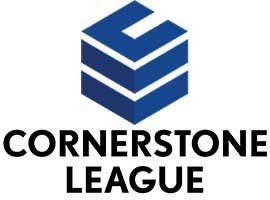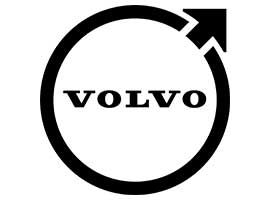Cohesion Culture™ 4 C’s
Communication, Creative Thinking, Collaboration, & Conflict Resolution
Cultivate a powerful workplace that excels in the 4 C’s of leadership – Communication, Collaboration, Conflict Resolution, and Creative Thinking.
The success of a company hinges on its ability to communicate effectively, think creatively, collaborate seamlessly, and navigate conflicts efficiently. Dr. Troy Hall and Ben-Jamin Toy specialize in guiding executive leadership teams to build and direct successful workforces by instilling the principles of the 4 C's.
Throughout this program, corporate officers, directors, and team leaders are instructed on techniques that enhance individual skills to strengthen and streamline the teams that they captain.
-
How can organizations utilize effective communication among remote teams?
-
Whether your team operates in-person, remotely, or through a hybrid model, the cohesiveness of your team, the strength of interpersonal relationships, the level of communication upward, downward and sideways, and the strength of leadership significantly impact daily operations and long-term success. Even in remote work scenarios, addressing business decisions and resolving conflicts efficiently through cohesive communication is crucial. According to TeamStage, effective communication generates a 4.5 times higher success rate in employee retention.
Equip your outstanding executive team with the tools needed to create a cohesive, productive, and committed workplace community. Step out of the boardroom and engage in thought-provoking, purposeful executive leadership enrichment with the 4 C's of Building a Strong C-Suite.
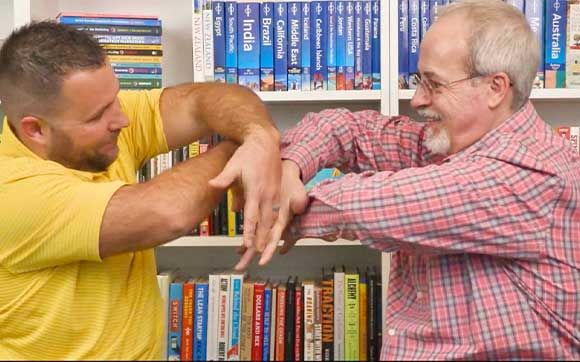
What is needed to have collaboration?
Collaboration involves both need and trust. When the strategic elements of cohesion (belonging, value, and commitment) are in play, teams naturally gravitate towards collaborative opportunities to achieve desired outcomes. Dr. Troy and Ben-Jamin recognize two main pain points facing organizational leaders in the area of teamwork:
-
- 86% of leaders blame lack of collaboration as the top reason for workplace failures.
-
- 39% of employees say people at their organization do not collaborate enough.
-
Dr. Troy recommends the Cohesion Culture 4 C’s program to tie communication into the activities for collaboration, conflict resolution, and creative thinking to reduce or eliminate the pain points associated when employees fail to work together. To emphasize the importance of collaboration, Dr. Troy and Ben-Jamin start with an activity rightfully named: Eyes, Body, Voice.
This lively interactive exercise allows executive leaders an opportunity to reflect upon how the three roles associated with eyes, body, and voice align with other key roles within the organization. Furthermore, leaders are encouraged to think how managers and individual contributors might perceive those roles and what can be done to maximize the efforts and effectiveness of vision, leadership, and action based on the roles of eyes, body, and voice.
The Eyes, Body, Voice activity is perfect for participants to experience the true art of collaboration. Two requirements of cohesive collaboration within the strategic framework asks participants to:
- Agree they need each other.
- Trust that each person will do their job.
The real fun begins.
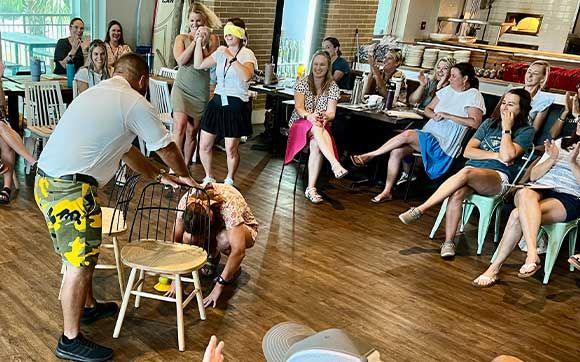
Three teams of three are selected and presented with the chance to achieve two desired outcomes. The first is to find a ball on a cone somewhere within the defined playing space of the activity. The second is to place the ball on a cone located in another part of the playing area.
Participants are challenged to overcome language barriers, maneuver around obstacles, and apply what they observe from one team outing to the next. They may not develop a plan prior to the game master saying "start."
During the explanation of the game, the leaders seem fairly confident they can accomplish the task until they realize the nature of the barriers and obstacles.
The one serving as the "eyes" is the only one who can see where the ball and cone have been placed. Both the "body" and the "voice" are blindfolded. Given these parameters, the body may only move based on instructions provided by the "voice." The "voice" may only speak from the implied instructions from the "body" who has permission to give commands to the "voice" through HR appropriate touching.
Those not selected to participate in one of the three teams serve as observers and play an important role during the debriefing.
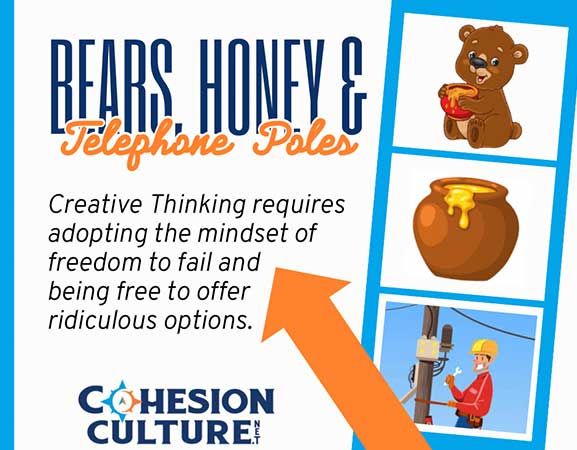
How do bears, honey, and telephone poles impact creative thinking?
Afraid of making a mistake? Fear the choice made is not a popular one? Will failure inhibit growth, development, and advancement?
These questions are real and the mindset behind them often paralyzes the leader from being innovative or creative. Creative thinking requires leaders to have a willingness to be wrong, experiment, and assume a "moderate risk of failing" thought process.
-
What percentage of people fear making a mistake?
50% of people in the U.S. fear making a mistake. It jumps to 52% in the U.K.
-
To help leaders overcome the fear of failing, they are invited to participate in an activity labeled: Mind Reader. The game board includes circles placed on the floor in columns of like colors. Participants are given minimal instructions with the objective of moving from one side of the playing area to the other side in a continuous motion without making a mistake. Only the game master knows the correct sequence. If a step taken is correct no sound is made; however, if it is wrong, the participant hears a "buzz" sound. This indicates their turn is over. The next person moves along the board until successfully getting to the end.
The objective is to practice becoming comfortable with non-blame worthy mistakes as learning opportunities. This process will allow for initiative and logic even if the result is less desirable. Ultimately, creative thinking leads to innovation. Innovation leads to revenue. Creativity = Value.
Engage a creative thinking process to solve needs.
Bears, honey, and telephone poles is a story about how a group of engineers solved a problem of ridding ice from telephone lines in Canada.
This anecdotal tale brings emphasis for the need of ridiculousness to be part of the creative process. In brainstorming, all ideas are accepted and documented. Once ideas have been generated, then it is time for the process to qualify the recommended solution.

How can conflicts be resolved quickly?
Conflicts naturally arise when communication between people involves misunderstandings, unclear expectations, skepticism, unresolved dialogue, and mistrust.
Following Dr. Troy's proven Cohesive Communication four step process prepares individuals for conversations to gain insight, uncover truths, and/or move ideas forward.
Build on the framework of a Cohesion Culture™ where people are seen and heard, individuals are valued for the meaningful contributions they make, and every individual has the opportunity to be needed and trusted.
-
“Why?” questions signal a defensive mechanism in the brain.
-
The intent of Cohesive Communication is to focus the conversation on self-discovery and moving the conversation forward, not finding guilt-ridden blame, expressing negative emotions, being stuck in the past, and certainly not to making others wrong.
Participants learn to replace "why?" questions in step 3 of the process. Through open-ended, non-leading questions, the interviewer will discover the "why" by rephrasing questions to be open and non-leading. Eliminating "why" from the structured series of questions keeps the interviewee from going into defense mode. Cohesive Communication teaches individuals a four step process Dr Troy calls "S.E.E.D.
- SET the stage: Posturing/Positioning, understanding the reason for the meeting.
- EMOTIONAL connection: Connecting and reflecting in an affirming manner what the other person might be feeling, thinking, saying, and doing. This is a perfect opportunity to identify a charactertistic or attribute that favors the person. (See page 20 of the Cohesion Culture book for examples of 7 attributes of an effective leader of cohesion.)
- ENGAGE self-discovery: Asking open-ended, non-leading questions to lead the recipient through self-discovery. Do more selling and less telling. Never ask why because it sends a message to the brain that leads one to become defensive. Remove the need to protect oneself and they can move toward belonging, self-esteem, and self-actualization.
- DEBRIEF for agreements: Confirming what was heard, gaining agreement for next steps, and offering support as needed.
During the Cohesion Culture™ 4 C’s session, participants will experience creative, hands-on activities that translate to a corporate environment. A customized, interactive approach is aimed at turning real world, day-to-day problems into puzzles that can be solved through a harmonious and unified team. The expertise learned through modules and challenges encourage inspired leadership, with learned skills and benefits carrying well beyond the boardroom.
Participants will experience:
- Enhanced Individual Performance: Techniques that enhance individual performance to strengthen and streamline the teams that they captain.
- Replicable Workplace Activities: Take part in activities designed for easy replication in the workplace, fostering a culture of continuous improvement.
Team Building and Bonding: Reinforce and create a sense of camaraderie through team building activities that go beyond the ordinary, creating lasting connections among team members

